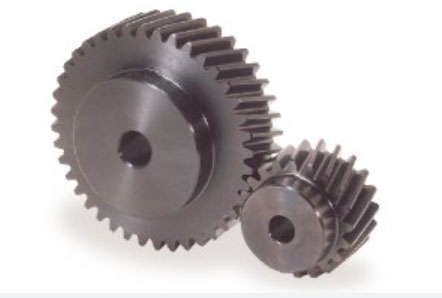Helical gears are an integral part of many mechanical systems, providing efficient power transmission and smooth operation. Understanding the science behind helical gears involves delving into their mechanics and design principles. In this article, we will explore the fundamental aspects of helical gears and shed light on the science that governs their operation.

- Helical Tooth Profile: Unlike spur gears with straight teeth, helical gears feature teeth that are cut at an angle along the gear’s circumference. This angle is known as the helix angle. The helical tooth profile enables gradual tooth engagement, resulting in smoother and quieter operation compared to spur gears. The helix angle also affects the tooth strength, load distribution, and gear meshing characteristics.
- Axial Thrust: Due to the helical tooth arrangement, helical gears generate an axial thrust force along the gear axis during operation. This axial thrust needs to be properly managed to prevent excessive axial loading on the gear shafts. Techniques such as thrust bearings or double helical gear arrangements (herringbone gears) can counteract the axial thrust and maintain proper gear alignment.
- Contact Ratio: The contact ratio refers to the number of teeth in contact at any given time during the gear meshing process. Helical gears typically have a higher contact ratio compared to spur gears. The increased contact ratio results in a larger contact area and improved load distribution, reducing tooth stresses and increasing the gear’s load-carrying capacity.
- Gear Meshing and Tooth Loading: The meshing of helical gears involves the gradual engagement of the helical teeth as they come into contact. This gradual meshing reduces impact forces and helps distribute the load across multiple teeth, minimizing localized tooth stresses. It also results in a smoother transfer of power, reduced noise, and improved gear performance.
- Gear Efficiency and Power Transmission: Helical gears offer high efficiency in power transmission. The helical tooth profile allows for more teeth in contact at any given time, resulting in better load distribution and reduced sliding friction. The increased contact area and gradual tooth engagement contribute to higher power transmission efficiency compared to other gear types.
- Helix Angle and Gear Performance: The helix angle is a critical parameter that influences gear performance. A larger helix angle increases the gear’s axial thrust and allows for a greater load-carrying capacity. However, larger helix angles may also introduce axial forces and require additional measures to counteract them. Balancing the helix angle with other design considerations is crucial for optimizing gear performance.
- Gear Design and Manufacturing Considerations: The design of helical gears involves careful consideration of factors such as pitch diameter, module, pressure angle, face width, and helix angle. These parameters impact gear strength, contact pattern, tooth geometry, and overall performance. Precision manufacturing techniques, such as CNC machining or gear hobbing, ensure accurate gear profiles and tight tolerances, resulting in high-quality helical gears.
By understanding the mechanics and design principles behind helical gears, engineers and designers can effectively optimize gear systems for specific applications. The science behind helical gears enables the creation of efficient and reliable power transmission systems that meet the demands of various industries, including automotive, aerospace, industrial machinery, and more.
